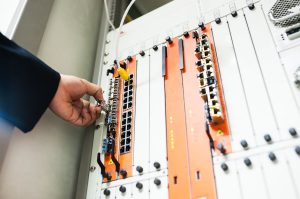Verizon Partners with AWS to Revolutionize Network Infrastructure for AI Workloads
Verizon Business Expands Network Services with AWS Partnership

Pexels
As industries worldwide pivot to leverage generative AI, the demands on network infrastructure have skyrocketed. Verizon Business, in collaboration with Amazon Web Services (AWS), is taking significant strides to meet these demands. The partnership focuses on integrating long-haul fiber routes that interconnect critical AWS data centers, aiming to enhance stability and performance for AI-powered tasks. Such advancements are crucial for enterprises relying on real-time data processing, shared AI model training, and robust cloud-based tools for enhanced decision-making.
This initiative is part of Verizon’s broader strategy to redefine networks for the AI era. Facilitating faster connectivity and reliable data pipelines directly addresses the latency and compliance challenges faced by organizations harnessing AI. According to McKinsey, the future of AI workloads, which will increasingly rely on live AI inference and decision-making by the end of this decade, makes this development even more vital for sustaining innovation and growth.
The Role of Verizon AI Connect in Accelerating AI Innovation

Pexels
At the forefront of this evolution is Verizon AI Connect—a suite of purpose-built network services for accommodating AI workloads. Rather than building anew, Verizon is optimizing its existing infrastructure by enhancing aspects such as 5G technology, edge computing, fiber optic connectivity, and energy-efficient cooling for large-scale systems. By doing so, Verizon is not only addressing current demands but also future-proofing its network against the anticipated surge in AI adoption.
This improvement benefits businesses directly. A practical example lies in fraud detection for financial institutions—accelerated datasets can reduce false positives and avoid disruption to critical business operations. Enhanced speeds shorten AI model training cycles and allow enterprises to test innovative ideas faster, all the while preventing performance degradation for applications sharing the same network.
Strategic Partnerships Push AI Networking to New Heights

Pexels
Partnerships with tech giants like NVIDIA, Vultr, and Google Cloud further exemplify Verizon’s commitment to redefining network capabilities. NVIDIA is collaborating with Verizon to deploy GPU-powered platforms within private 5G networks, which provide localized AI processing capabilities. Vultr’s partnership enables Verizon customers to access GPU computing on-demand, simplifying training and inference workflows. Furthermore, Google Cloud and Verizon are working together to harness AI systems that mitigate network issues proactively, minimizing service disruptions.
Collaborations like these emphasize that sustainable AI performance hinges on the seamless coordination of network architectures, data management, and endpoint security. Verizon and its partners are intent on bridging the technical gaps that slow down AI execution, empowering organizations to optimize their workflows without compromising on stability or compliance.
Overcoming Challenges and the Future of AI-Driven Networks

Pexels
However, challenges still loom large. Businesses need better clarity regarding network traffic patterns and have to balance escalating costs associated with moving massive datasets across cloud regions. Moreover, regulatory compliance requirements add another layer of complexity to routing decisions. AI-specific workloads can also exhibit unpredictable spikes, demanding robust mechanisms for forecasting and management.
The push to bring AI closer to end-users and devices is spearheading a structural transformation in network designs. As companies continue to invest in reducing latency and improving reliability, integration between network, cloud, and security teams will be instrumental in shaping the user experience. In sectors where the slightest delays can lead to significant financial or operational consequences, having superior network infrastructure could serve as a powerful competitive differentiator.


